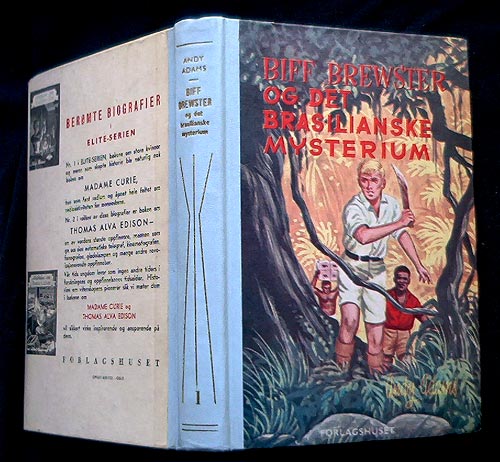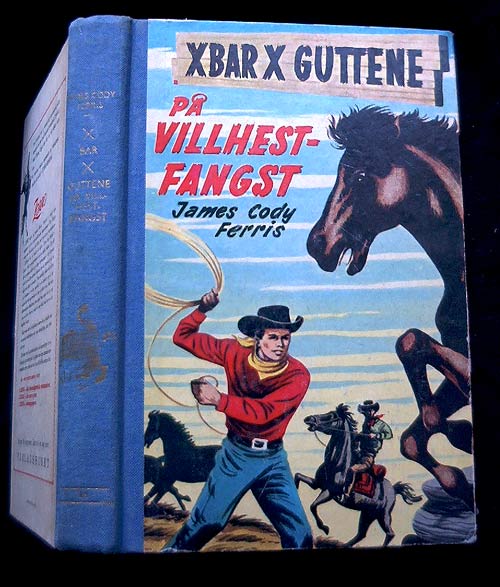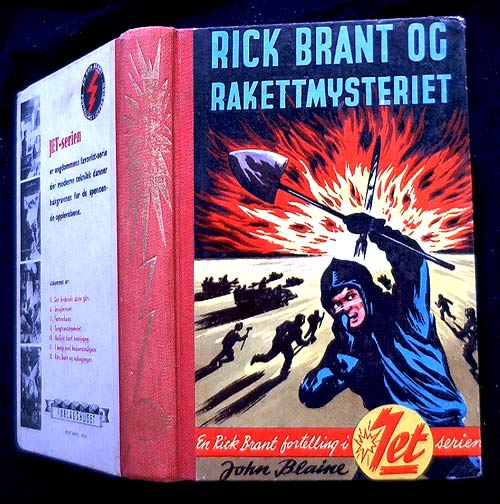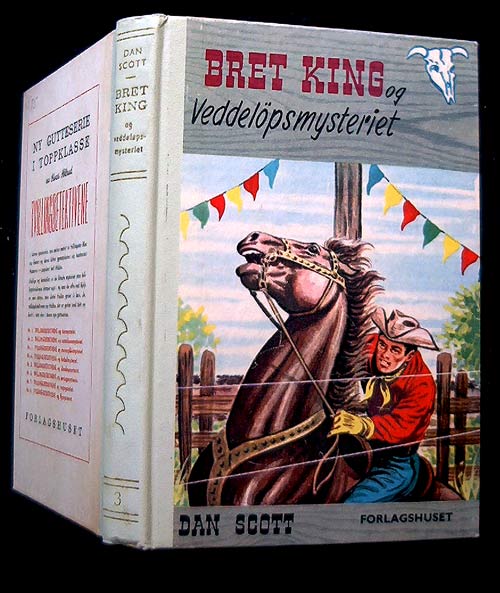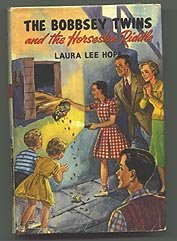




Most vintage children's mystery series book fans are aware of the pull-out, tri-fold ad featured in select volumes of the Hardy Boys, Nancy Drew, Tom Swift Jr., the Bobbsey Twins and Cherry Ames published in 1964. The cardboard advertisment measures about 11 inches by 7 1/2 inches and is printed with orange and black on white. It features tiny illustrations of 19 different book series characters published by Grosset & Dunlap at that time. With each illustration is a clue to the name of the character and the answer to the quiz is on the bottom right side of the lineup printed upside down.
I first discovered this advertisement in the mid-1960s and like most kids might do, I tore it out and cut it up into sections. I still have those cardboard cutouts and display them on a magnet on my refrigerator. When I became a serious book collector many years later, I started searching for books that had the ad and I still enjoy doing so. In fact, recently I found a set of Hardy Boys books at a book store that had the ad in the 1964 edition. A few years ago I found a set of Nancy Drew that had the ad in one of the books.
So I have become slightly obsessed with finding books with the ad. And I am curious as to how many more books may have had the ad that I don't know about.
What is unique about the ad is that there is not alot of promotional material about the Grosset & Dunlap books out there and this ad stands out as one of the few pieces readily available for collectors today. You can find books with the ad on eBay occasionally and those books will sell at high prices and sometimes at low. Sometimes seller's are not aware the ad is in the book they are selling and many times buyers inquire through the eBay messaging system.
The books with ads that sell higher on eBay are the volumes in the Hardy Boys and Nancy Drew, and that is because those books are first editions, too, and the Hardy Boys and Nancy Drew have more devoted fans. However, not every edition with the tri-fold ad is a first edition, but every edition is a picture cover edition. Here is the list of books with the tri-fold ad that I am aware of and most I have in my collection:
THE HARDY BOYS, THE MYSTERY OF THE AZTEC WARRIOR (43) Any volume of this book with the ad is a true first edition. This book will sell for more than $100 many times on eBay, but usually only with the ad in it. I have seen several eBay auctions where the seller will mention that there is sign the ad was torn out of the book. Note, the ad is always at the back of the book after the last page of text and always before the endpapers. As in the Nancy Drew volume with the ad, Aztec Warrior is the last title of Hardy Boys books on the back cover, but the Hardy Boys always lists its' detective handbook right afterward.
I recently found another Aztec Warrior with the back cover titles that match a first edition, but the ad was not present and I could not detect any signs the ad was ever in that book. But there is one strange thing about this book, on the copyright page it has "11/64" printed under the Grosset & Dunlap trademark, and my copy with the ad does not have that notation. I don't know what that means or its' significance, but possibly this edition was printed months after the initial printing with the ad.
NANCY DREW THE CLUE OF THE WHISTLING BAGPIPES (41). Because of the immense popularity of Nancy Drew, this book will always garner high prices on eBay, but again as long as the ad is present. This is another first edition book that ends with itself as the last title on the back cover.
It should be noted that the tri-fold ad has a list of titles for several series and the user of the ad could cut off a post card to buy the books ($1.25 each). The ad that appears in girls books lists only books for girls. Every reader of series books has found a book with check marks next to the list of books in that series, indicating which books the owner had read. This tri-fold ad has a convenient set of titles with boxes one can check. Many times you will find an ad with boxes checked or the post card detached. Collectors desire copies of the ad that are mint and untouched!
The girls series listed on the ad for one to check include Nancy Drew, Dana Girls, Vicki Barr, Peggy Lane, Judy Bolton, Connie Blair and Cherry Ames. The boys series listed in boys books are the Hardy Boys, Tom Swift Jr., Fury Horse Stories, Rick Brant, Bret King, Chip Hilton, Biff Brewster, Tom Corbett, Space Cadet, Bronc Burnett and Ken Holt.
TOM SWIFT AND HIS AQUATOMIC TRACKER (23). Last title on the back cover is #22, Tom Swift and His Repelatron Skyway. This is another first edition and I believe that another TSJR book had the ad, possibly #1 Flying Lab, but I can't document this. More on this at the bottom.
CHERRY AMES STUDENT NURSE (1) and CHERRY AMES COMPANION NURSE (24). The latter title was published in 1964 and is a first edition. I have a copy of Student Nurse with the ad but was only aware of the latter book in a recent eBay auction. I thought I had seen an ad in Jungle Nurse, but that can't be because it was published in 1965. Student Nurse lists to Country Doctor's Nurse and Book of First Aid and Home Nursing.
THE BOBBSEY TWINS AND THE GREEK HAT MYSTERY (57) It is another first edition and lists to And the Big River Mystery on the back cover. On this book, the list of series books you can check include the Bobbsey Twins, Honey Bunch and Norman, and books by Thornton W. Burgess Books, and in doing this article, I notice for the first time that there is room for listing some Dana Girls titles under the heading of: "Are you ready for the Dana Girls?"
It is interesting and obviously smart that Grosset & Dunlap varied the tri-fold ads for the assumed readers of the book the ad came in. Thus, in boys books, the list of titles to check and order were boys books and girls books for girls and in this case, the Bobbsey Twins ad was aiming at children who wanted similar titles, yet there was some room left so the marketing department of G&D decided to include the Dana Girls under the headline "Are you ready for the Dana Girls?"
This article is a summation of what I know about the tri-fold ad that appeared in one year, 1964, and was never seen again. I do have questions of whether any more books had the ad, such as in the Ken Holt, Rick Brant, Dana Girls, Judy Bolton and the other series that this ad promoted. I hope anyone reading this and knowing of other examples will contact me. I have recollections that one more TSJR book had the ad. But I can't verify that. The finding of Cherry Ames Companion Nurse recently on eBay with the ad was very pleasing.
In the future I will be placing ads on my blog featuring department store ads for children's mystery series book (such as in catalogs) and I will place pictures from a G&D catalog I once owned that came out in the late 1960s. Stay tuned!



















































